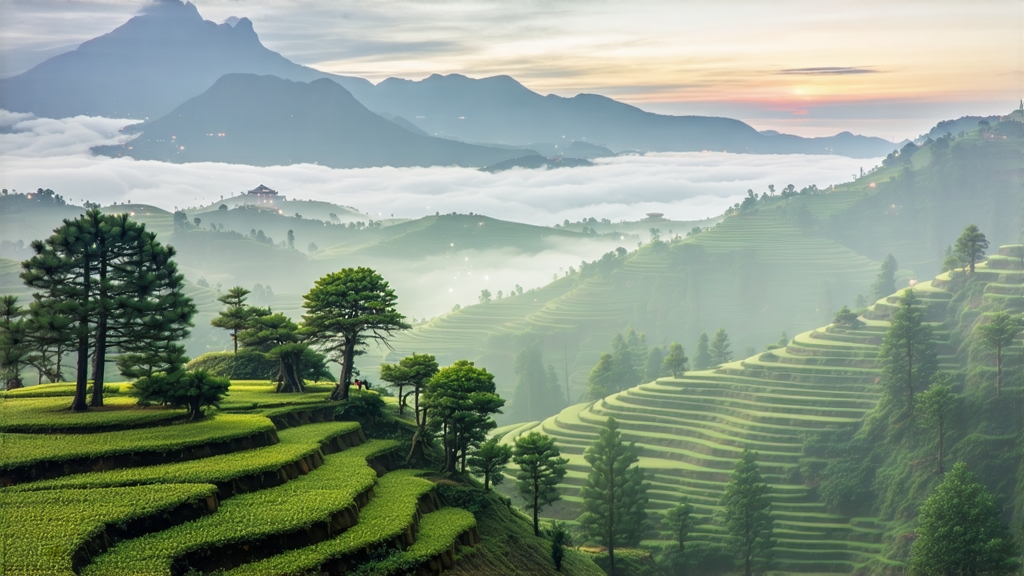
If green tea is China’s fresh-faced poet and pu-erh its venerable historian, then Phoenix Dancong—Fenghuang Dancong in Mandarin—deserves the mantle of the country’s most eloquent troubadour. Grown on the steep, granite spines of Phoenix Mountain in northern Guangdong, this oolong sings in fragrances that mimic peach blossom, gardenia, almond, or even spiced honey, depending on which of the dozens of aromatic “fragrance types” (xiang xing) a particular tree expresses. Yet behind the perfume lies a story of survival: centuries of selection by monks and farmers, typhoons that snapped branches, market booms and busts, and, most recently, a global awakening to its layered complexity. To understand Phoenix Dancong is to listen to a living archive of Chinese tea craft, where every leaf is both a time capsule and a fresh improvisation.
Historical roots
Local chronicles credit the Song dynasty (960-1279 CE) for the first systematic cultivation. When imperial retinues fled southward ahead of Jurchen cavalry, courtiers supposedly carried cuttings of prized tea trees from Fujian. On the fog-cooled slopes of Wudong, Dajing, and Wuji peaks—elevation 350–1,300 m—the cuttings thrived, mutating into what locals called “Dancong,” literally “single bush.” The name signals both genetic individuality and the practice of harvesting each old tree separately to preserve its unique bouquet. By the late Ming, Dancong had entered tribute lists; Qing-era gazetteers record tea officers stationed at Chaozhou who graded leaf by scent before shipping northward on the Grand Canal. Maritime trade later ferried it to Southeast Asia, where Teochew migrants brewed tiny cups beside ancestral tablets, ensuring the cultivar’s diaspora long before Western specialty shops discovered it.
Micro-terroir and garden ecology
Phoenix Mountain is a tilted block of acidic granite weathered into sandy loam. Day-night temperature differentials can exceed 15 °C; mist blocks intense sunlight, lengthening the vegetative cycle and concentrating aromatic precursors. Within an area barely 30 km across, micro-valleys create pockets of humidity that coax different scent profiles. The most celebrated gardens—Wudong’s “Eight Famous Cliffs,” including Liping, Zhugou, and Wudong itself—sit above 800 m, where 200- to 600-year-old trees send roots into crevices so narrow that pickers must tie themselves to iron chains. At lower elevations, newly planted bushes yield softer, less mineral liquor, yet can still captivate when handled by skilled hands. Crucially, every old tree is grafted onto its own rootstock rather than cloned; thus each “fragrance type” is both cultivar and vintage, a botanical soloist rather than a choir.
From leaf to song: craft stages
- Plucking: only the middle 3–4 leaves are taken once the spring shoot reaches “small open face,” when the terminal bud swells but has not yet hardened. This ratio of stem, bud, and mature leaf provides the polyphenolic backbone for later oxidation.
- Solar withering: trays are set on mountain ledges for 20–40 min of late-morning sun. UV light triggers enzymatic activity while a gentle breeze removes surface moisture—critical for the signature “mountain air” note.
- Indoor withering and bruising: leaves are alternately shaken in bamboo drums and left to rest for 6–10 hours. Edge bruising oxidizes catechins, turning leaf rims crimson while veins stay green; the rhythm of toss-rest-toss is guided by scent: when peach skin and jasmine lift from the pile, the tea master knows oxidation has reached 30–35 %.
- Pan-kill: a 260 °C wok arrests oxidation within 90 s, locking in a kaleidoscope of floral volatiles.
- Rolling: cloth-wrapped leaves are twisted under foot-powered boards, rupturing cells so oils migrate to the surface.
- Baking: the first charcoal fire (100 °C) lasts 2 hours; after a fortnight’s rest, a second low fire (80 °C) deepens sweetness. Master bakers use lychee-wood embers, claiming the fruit tree’s smoke lends a clean, lingering finish. The entire cycle spans 36 hours, yet the tea is still “raw”; months of post-fermentative maturation allow charcoal heat